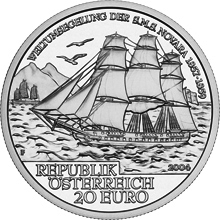SMS Novara, an Austrian Navy frigate, completed one of the more significant circumnavigations of the 19th century. The ship’s historic journey began on April 30, 1857, and it had the distinction of being the first round-the-world voyage undertaken by the Austrian Empire.
The Novara Expedition was a large-scale scientific mission authorized by Archduke Maximilian, the younger brother of Austrian Emperor Franz Joseph I. Those on board Novara for the expedition were 345 naval officers and crewmen, along with seven renowned natural scientists. The scientists, who included geologist Ferdinand von Hochstetter and zoologist Georg von Frauenfeld, used the voyage to conduct seminal research at various places across the globe.
The three-masted Novara sailed under the command of Captain Bernhard von Wüllerstorf-Urbair. He brought to the pioneering mission not only considerable maritime expertise but also a vast range of scientific knowledge. This knowledge enabled him to give valuable advice to the scientists during many of their investigations and experiments en route.
The Novara Expedition resulted in a number of major breakthroughs in oceanographic and hydrographic studies, especially during the part of the voyage spent in the South Pacific. In addition, the research that was conducted on geomagnetism throughout the journey likewise yielded new and even revolutionary discoveries.
An account of the ship’s voyage and the scientific findings it made possible were eventually published as a 21-volume work entitled “Reise der österreichischen Fregatte Novara um die Erde” (“Journey of the Austrian frigate Novara around the earth”). This work included a drawing of Novara surrounded by an oval border containing the names of the following places visited during the expedition: Gibraltar; Madeira; Rio de Janeiro; Cape Town; Saint Paul Island (more than three decades before it formally became one of France’s Indian Ocean territories); Ceylon (present-day Sri Lanka); Madras (a city in India now known as Chennai); Nicobar Islands (located in the eastern Indian Ocean); Singapore; Batavia (a city in Indonesia now known as Jakarta); Manila; Hong Kong; Shanghai; Puynipet Island (a northwestern Pacific island now called Pohnpei); Stewart Island (a South Pacific atoll now known as Sikaiana); Sydney; Auckland; Tahiti; Valparaíso; Gravosa (now the Croatian city of Dubrovnik); and Trieste.

The Novara Expedition was commemorated in a euro coin that was minted in 2004. This coin depicts the ship sailing along the Chinese coast.
Further information on SMS Novara, including her 1857-59 voyage around the world, can be found at https://en.wikipedia.org/wiki/SMS_Novara_(1850)


Leave a comment